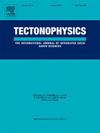由岩石圈非均质性调节的青藏高原东北部差异变形机制
IF 2.6
3区 地球科学
Q2 GEOCHEMISTRY & GEOPHYSICS
引用次数: 0
摘要
确定分布的陆内变形的驱动机制是大陆构造学的一个重要课题。宽约2000 km的新生代喜马拉雅-青藏造山带及其相关的加厚青藏高原是研究板内变形的典型大陆-大陆碰撞。关于这个造山带如何适应板块收敛,有两种有争议的范式。前者强调了刚性块体的运动和平移,而后者将岩石圈变形量化为流动连续体。这两个模型都被用来量化青藏高原东北边缘的变形,那里的变形远离任何板块边界的相互作用。为了探究这一问题,本文利用藏东北地区的地震剖面资料,进行新的s波接收函数、联合反演成像和区域综合,建立了青藏高原北部和东部边缘差异变形机制的岩石圈尺度的综合结构模型。北部高原边缘是一个复杂的岩石圈逆冲-楔系统,具有多个拆离带,可容纳陆内斜下冲/俯冲。相反,东部高原边缘不表现出离散的断层结构,似乎是通过地幔熔融引起的热而弱的中下地壳的垂直膨胀而变形的。我们将这些不同的变形类型归因于岩石圈显著的垂直和横向非均质性,主要受反映新生代火山活动和前新生代地体增生近代性的温度变化的控制。我们的研究结果为塑造大陆碰撞带发展的板内过程和地球动力学提供了全面的见解。本文章由计算机程序翻译,如有差异,请以英文原文为准。
Differential deformation mechanisms in the northeastern Tibetan plateau modulated by lithospheric heterogeneities
Determining the driving mechanisms for distributed intracontinental deformation is an important topic in continental tectonics. The ∼2000-km-wide Cenozoic Himalayan-Tibetan orogen and the related thickened Tibetan plateau represent an archetypical continent-continent collision to study intra-plate deformation. There are two debated paradigms for how this orogen accommodates plate convergence. The first highlights the motion and translation of rigid blocks, whereas the second quantifies lithospheric deformation as a flowing continuum. Both models have been used to quantify deformation at the northeastern margin of the Tibetan plateau, which deforms far from any plate-boundary interactions. To interrogate this issue, here we use seismic profiling data collected in northeastern Tibet to conduct new S-wave receiver functions, joint inversion imaging, and regional synthesis to develop a comprehensive lithosphere-scale structural model of the differential deformation mechanisms operating along the northern and eastern margins of the Tibetan plateau. The northern plateau margin is dominated by a complex lithospheric thrust-wedge system with multiple detachment zones that accommodate intracontinental oblique underthrusting/subduction. Conversely, the eastern plateau margin does not exhibit discrete fault structures and appears to deform via the vertical inflation of a hot and weak mid-lower crust induced by mantle melting. We attribute these different styles of deformation to significant vertical and lateral lithospheric heterogeneities, governed primarily by temperature variations reflecting the recency of Cenozoic volcanism and pre-Cenozoic terrane accretion. Our results provide comprehensive insights into the intraplate processes and geodynamics that shape the development of a continental collisional zone.
求助全文
通过发布文献求助,成功后即可免费获取论文全文。
去求助
来源期刊

Tectonophysics
地学-地球化学与地球物理
CiteScore
4.90
自引率
6.90%
发文量
300
审稿时长
6 months
期刊介绍:
The prime focus of Tectonophysics will be high-impact original research and reviews in the fields of kinematics, structure, composition, and dynamics of the solid arth at all scales. Tectonophysics particularly encourages submission of papers based on the integration of a multitude of geophysical, geological, geochemical, geodynamic, and geotectonic methods
 求助内容:
求助内容: 应助结果提醒方式:
应助结果提醒方式:


